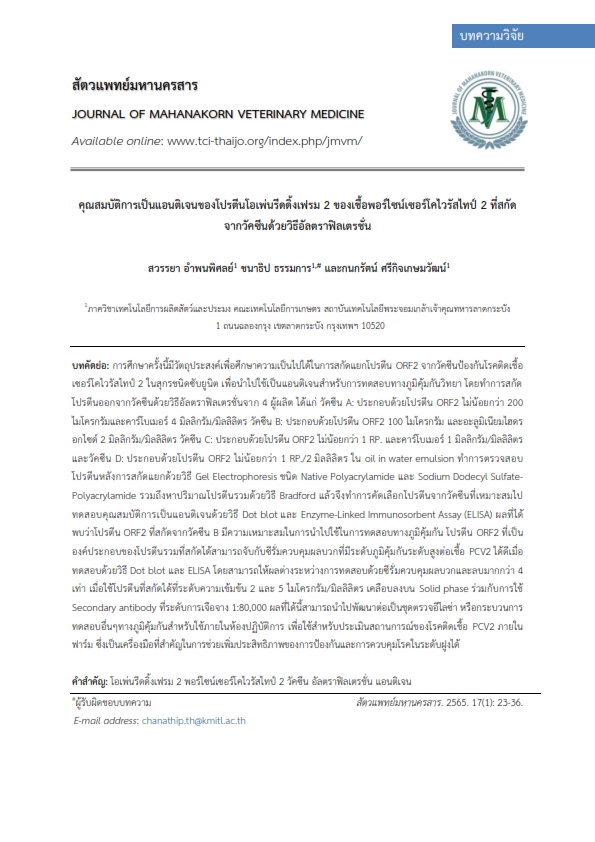Antigenic Properties of Open Reading Frame 2 protein of Porcine Circovirus Type 2 from Vaccines Extracted by Ultrafiltration Method
Main Article Content
Abstract
The purpose of this study was to determine the feasibility of extracting Open reading frame 2 (ORF2) protein from subunit vaccine against Porcine Circovirus type 2 infection, for the propose using as antigen for immunological testing. Proteins were extracted from vaccines by ultrafiltration from four manufacturers: Vaccine A: contains at least 200 mcg of ORF2 protein and 4 mg of carbomer per 1 ml. Vaccine B: contains 100 mcg of ORF2 protein and 2 mg of Aluminium hydroxide per 1 ml. Vaccine C: contains at least 1 RP. of ORF2 protein and 1 mg of carbomer per ml. Vaccine D: contains at least 1 RP. of ORF2 protein and oil in water emulsion per 2 ml. Total extracted proteins were assayed by gel electrophoresis using Native Polyacrylamide and Sodium Dodecyl Sulfate- Polyacrylamide methods. Then the total proteins were examined by Bradford method. Finally, the extracted proteins from suitable vaccine were further examined for their antigenic properties using dot blot and Enzyme-Linked Immunosorbent Assay (ELISA). The results revealed that the extracted ORF2 protein from vaccine B is suitable for use in immunological testing. The ORF2 protein which included in total extracted proteins solution able to bind to high immune level positive control serum against PCV2 by dot blot method as well as ELISA test. The difference between the positive and negative control serum was more than 4 times when 2 and 5 µg/ml of extracted proteins applied to the solid phase and 1:80,000 dilution of secondary antibody was used. The obtained results could be further developed into an ELISA assay or other immunological testing procedures for use as in-house testing. The tests can be used for assessing the situation of PCV2 infection disease in the farms, which are important tools to enhance the effectiveness of prevention and control of the disease at the herd level.
Article Details

This work is licensed under a Creative Commons Attribution-NonCommercial-NoDerivatives 4.0 International License.
References
Bollag, D. M. E., S. J. Rozycki, M. D. Bollag, M. D. Rozycki, and S. J. Edelstein. 1996. Protein methods. (No. 547.96 BOL).
Boyer, R. F. 2012. Biochemistry laboratory: modern theory and techniques. 2nded. Prentice Hall. New Jersey. 166-175.
Bradford, M. M. 1976. A rapid and sensitive method for the quantitation of microgram quantities of protein utilizing the principle of protein-dye binding. Anal. Biochem. 72: 248-254.
Buapijit, K. 2015. Development of indirect PCV2b-based ELISA for detection PCV2 antibodies. Department of Veterinary Medicine, Faculty of Veterinary Science, Chulalongkorn University.
Chae, C. 2012. Commercial porcine circovirus type 2 vaccines: efficacy and clinical application. Vet. J. 194: 151–157.
Ellis, J., M. Spinato, C. Yong, K. West, F. McNeilly, B. Meehan, S. Kennedy, E. Clark, S. Krakowka, and G. Allan. 2003. Porcine circovirus 2-associated disease in Eurasian wild boar. J. Vet. Diagn. Invest. 15(4): 364-368.
Liu, Q., S. K. Tikoo, and L. A. Babiuk. 2001. Nuclear localization of the ORF2 protein encoded by porcine circovirus type 2. J. Virol. 285: 91-99.
Mahe, D., P. Blanchard, C. Truong, C. Arnauld, P. Le Cann, R. Cariolet, F. Madec, E. Albina, and A. Jestin. 2000. Differential recognition of ORF2 protein from type 1 and type 2 porcine circoviruses and identification of immunorelevant epitopes. J. Gen. Virol. 81: 1815-1824.
Nawagitgul, P., I. Morozov, S. R. Bolin, P. A. Harms, S. D. Sorden, and P. S. Paul. 2000. Open reading frame 2 of porcine circovirus type 2 encodes a major capsid protein. J. Gen. Virol. 81: 2281-2287.
Pogranichnyy, R. M., K. J. Yoon, P. A. Harms, S. L. Swenson, J. J. Zimmerman, and S. D. Sorden. 2000. Characterization of immune response of young pigs to porcine circovirus type 2 infection. Viral. Immunol. 13(2): 143-153.
Seelapai, J. 2016. Screening, partial purification and characterization of cellulolytic enzyme from Actinomycetes. Department of Microbiology, Faculty of Science, Prince of Songkla University. (In Thai).
Sun, S. Q., H. C. Guo, D. H. Sun, S. H. Yin, Y. J. Shang, X. P. Cai, and X. T. Liu. 2010. Development and validation of an ELISA using a protein encoded by ORF2 antigenic domain of porcine circovirus type 2. Virol. J. 7: 274.
Truong, C., D. Mahe, P. Blanchard, M. Le Dimna, F. Madec, A. Jestin, and E. Albina. 2001. Identification of an immunorelevant ORF2 epitope from porcine circovirus type 2 as a serological marker for experimental and natural infection. Arch. Virol. 146(6): 1197-1211.
Zepeda-Cervantes, J., A. Cruz-Reséndiz, A. Sampieri, R. Carreón-Nápoles, J. I. Sánchez-Betancourt, and L. Vaca. 2019. Incorporation of ORF2 from porcine circovirus type 2 (PCV2) into genetically encoded nanoparticles as a novel vaccine using a self-aggregating peptide. Vaccine. 37: 1928–1937.


